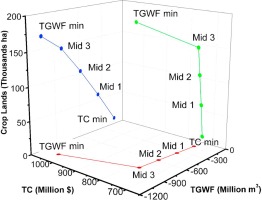Applied Energy ( IF 10.1 ) Pub Date : 2017-09-18 , DOI: 10.1016/j.apenergy.2017.09.070 Jia Zhong , T. Edward Yu , Christopher D. Clark , Burton C. English , James A. Larson , Chu-Lin Cheng

|
Producing renewable fuel from dedicated energy crops, such as switchgrass, has the potential to generate localized environmental benefits. This study uses high-resolution spatial data for west Tennessee to quantify the effects of producing switchgrass for cellulosic ethanol on the grey water footprint (GWF), or the amount of freshwater needed to dilute nitrate leachate to a safe level, relative to existing agricultural production. In addition, the estimated cost and GWF are incorporated in a mixed-integer multi-objective optimization model to derive the efficient frontier of the feedstock supply chain and determine a switchgrass supply chain that achieves the greatest reduction in GWF at the lowest cost. Results suggest that background nitrate concentration in ambient water and the types of agricultural land converted to switchgrass production influence the extent of the GWF. The average GWF of switchgrass in the study area ranges between 131.8 L L−1 and 145.9 L L−1 of ethanol, which falls into the range of estimated GWF of other lignocellulosic biomass feedstock in the literature. Also, the average cost of reducing GWF from the feedstock supply chain identified by the compromise solution method is $0.94 m−3 in the region. A tradeoff between biofuel production costs and reduced nitrate loading in groundwater is driven by differences in the agricultural land converted to feedstock production. Our findings illustrate the energy-water-food nexus in the development of a local bioenergy sector and provide a management strategy associated with land use choices for the supply of energy crops. However, the water quality improvements associated with displacing crop with feedstock production in one region could be offset by expanded or more intensive agricultural production in other regions.
中文翻译:

生物能源生产用地变化对原料成本和水质的影响
用柳枝such等专用能源作物生产可再生燃料具有产生局部环境效益的潜力。这项研究使用了田纳西州西部的高分辨率空间数据来量化生产纤维素乙醇的柳枝switch对灰水足迹(GWF)或相对于现有农业生产而言将硝酸盐渗滤液稀释至安全水平所需的淡水量。此外,将估计成本和GWF纳入混合整数多目标优化模型中,以推导出原料供应链的有效前沿并确定以最低成本实现GWF最大程度降低的柳枝supply供应链。结果表明,环境水中的背景硝酸盐浓度和转换为柳枝production生产的农地类型影响了全球自然基金会的程度。研究区域的柳枝average的平均GWF范围在131.8 L L之间-1和145.9 L L -1的乙醇,在文献中的其他木质纤维素生物质原料的估计GWF范围内。同样,通过折衷解决方案方法确定的从原料供应链中减少GWF的平均成本为94万美元-3在该区域。生物燃料生产成本与地下水中硝酸盐含量降低之间的权衡是由转化为原料生产的农业用地的差异驱动的。我们的发现说明了当地生物能源行业发展过程中的能源-水-食物关系,并提供了与土地用途选择相关的管理策略来供应能源作物。然而,在一个地区,用原料生产代替农作物而带来的水质改善可能被其他地区扩大或集约化的农业生产所抵消。











































 京公网安备 11010802027423号
京公网安备 11010802027423号